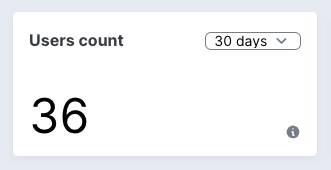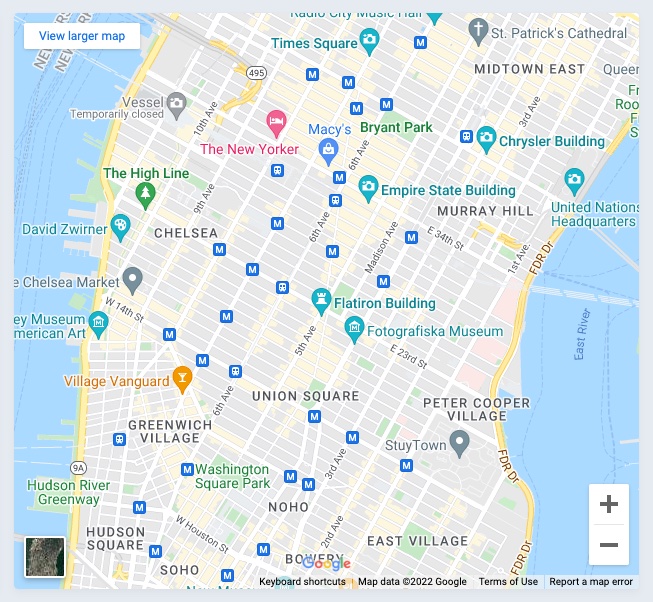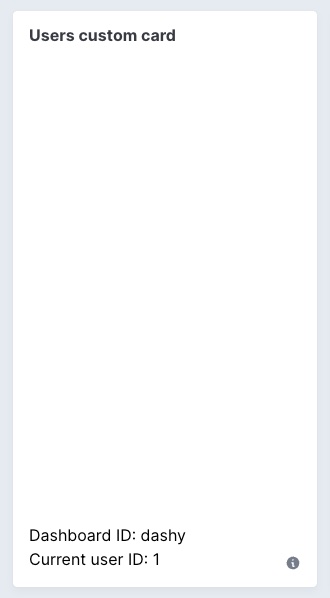Dashboards
WARNING
You must manually require the chartkick gem in your Gemfile.
# Create beautiful JavaScript charts with one line of Ruby
gem "chartkick"There comes the point in your app's life when you need to display the data in an aggregated form like a metric or chart. That's what Avo's Dashboards are all about.
Generate a dashboard
Run bin/rails g avo:dashboard my_dashboard to get a shiny new dashboard.
class MyDashboard < Avo::Dashboards::BaseDashboard
self.id = 'my_dashboard'
self.name = 'Dashy'
self.description = 'The first dashbaord'
self.grid_cols = 3
card ExampleMetric
card ExampleAreaChart
card ExampleScatterChart
card PercentDone
card AmountRaised
card ExampleLineChart
card ExampleColumnChart
card ExamplePieChart
card ExampleBarChart
divider label: "Custom partials"
card ExampleCustomPartial
card MapCard
end
Settings
Each dashboard is a file. It holds information about itself like the id, name, description, and how many columns its grid has.
The id field has to be unique. The name is what the user sees in big letters on top of the page, and the description is some text you pass to give the user more details regarding the dashboard.
Using the ' grid_cols ' parameter, you may organize the cards in a grid with 3, 4, 5, or 6 columns using the grid_cols parameter. The default is 3.
Cards
All cards have a few base settings and a few custom ones.
Base settings
All cards have some standard settings like id, which must be unique, label and description. The label will be the title of your card, and description will show a tiny question mark icon on the bottom right with a tooltip with that description.
Each card has its own cols and rows settings to control the width and height of the card inside the dashboard grid. They can have values from 1 to 6.
class UsersMetric < Avo::Dashboards::MetricCard
self.id = 'users_metric'
self.label = 'Users count'
self.description = 'Users description'
self.cols = 1
self.rows = 1
self.display_header = true
end
Control the aggregation using ranges
You may also want to give the user the ability to query data in different ranges. You can control what's passed in the dropdown using the' ranges' attribute. The array passed here will be parsed and displayed on the card. All integers are transformed to days, and other string variables will be passed as they are.
You can also set a default range using the initial_range attribute.
class UsersMetric < Avo::Dashboards::MetricCard
self.id = 'users_metric'
self.label = 'Users count'
self.initial_range = 30
self.ranges = {
"7 days": 7,
"30 days": 30,
"60 days": 60,
"365 days": 365,
Today: "TODAY",
"Month to date": "MTD",
"Quarter to date": "QTD",
"Year to date": "YTD",
All: "ALL"
}
endKeep the data fresh
If this dashboard is something you keep on the big screen, you must keep the data fresh at all times. That's easy using refresh_every. You pass the number of seconds you need to be refreshed and forget about it. Avo will do it for you.
class UsersMetric < Avo::Dashboards::MetricCard
self.id = 'users_metric'
self.refresh_every = 10.minutes
endHide the header
In cases where you need to embed some content that should fill the whole card (like a map, for example), you can choose to hide the label and ranges dropdown.
class UsersMetric < Avo::Dashboards::MetricCard
self.id = 'users_metric'
self.display_header = false
end
Override card options from the dashboard
We found ourselves in the position to add a few cards that were the same card but with a slight difference. Ex: Have one Users count card and another Active users count card. They both count users, but the latter has an active: true condition applied.
Before, we'd have to duplicate that card and modify the query method slightly but end up with duplicated boilerplate code. For those scenarios, we created the options attribute. It allows you to send arbitrary options to the card from the parent.
class Dashy < Avo::Dashboards::BaseDashboard
self.id = "dashy"
self.name = "Dashy"
card UsersCount
card UsersCount, options: {
active_users: true
}
endNow we can pick up that option in the card and update the query accordingly.
class UsersCount < Avo::Dashboards::MetricCard
self.id = "users_metric"
self.label = "Users count"
# You have access to context, params, range, current dashboard, and current card
def query
scope = User
if options[:active_users].present?
scope = scope.active
end
result scope.count
end
endThat gives you an extra layer of control without code duplication and the best developer experience.
Control the base settings from the parent
Evidently, you don't want to show the same label, description, and other details for that second card from the first card;. Therefore, you can control the label, description, cols, rows, and refresh_every options from the parent declaration.
class Dashy < Avo::Dashboards::BaseDashboard
self.id = "dashy"
self.name = "Dashy"
card UsersCount
card UsersCount,
label: "Active users",
description: "Active users count",
cols: 2,
rows: 2,
refresh_every: 2.minutes,
options: {
active_users: true
}
endCards visibility
Since v2.28It's common to show the same dashboard to multiple types of users (admins, regular users). In that scenario you might want to hide some cards for the regular users and show them just to the admins.
You can use the visible option to do that. It can be a boolean or a block where you can access the params, current_user, context, parent, and card object.
class UsersCount < Avo::Dashboards::MetricCard
self.id = "users_metric"
self.label = "Users count"
self.visible = -> do
# You have access to context, params, parent (the current dashboard), and current card
true
end
def query
result User.count
end
endYou may also control the visibility from the dashboard class.
class Dashy < Avo::Dashboards::BaseDashboard
self.name = "Dashy"
card UsersCount, visible: -> { true }
endCard types
You can add three types of cards to your dashboard: metric, chartkick, and partial.
Metric card
The metric card is your friend when you only need to display a simple significant number on your dashboard. Generate one run bin/rails g avo:card:metric users_metric.

Calculate results
To calculate your result, you may use the query method. After you run your query, use the result method to store the value that will be displayed on the card.
In the query method you have access to a few variables like context (the App context), params (the request params), range (the range that was requested), dashboard (the current dashboard the card is on), and current card.
class UsersMetric < Avo::Dashboards::MetricCard
self.id = 'users_metric'
self.label = 'Users count'
self.description = 'Some tiny description'
self.cols = 1
# self.rows = 1
# self.initial_range = 30
# self.ranges = [7, 30, 60, 365, 'TODAY', 'MTD', 'QTD', 'YTD', 'ALL']
# self.prefix = '$'
# self.suffix = '%'
# self.refresh_every = 10.minutes
def query
from = Date.today.midnight - 1.week
to = DateTime.current
Decorate the data using prefix and suffix
Some metrics might want to add a prefix or a suffix to display the data better.
class UsersMetric < Avo::Dashboards::MetricCard
self.id = 'users_metric'
self.prefix = '$'
self.suffix = '%'
end
Chartkick card
A picture is worth a thousand words. So maybe a chart a hundred? Who knows? But creating charts in Avo is very easy with the help of the chartkick gem.
You start by running bin/rails g avo:card:chartkick users_chart.
class UserSignups < Avo::Dashboards::ChartkickCard
self.id = 'user_signups'
self.label = 'User signups'
self.chart_type = :area_chart
self.description = 'Some tiny description'
self.cols = 2
# self.rows = 1
# self.chart_options = { library: { plugins: { legend: { display: true } } } }
# self.flush = true
# self.legend = false
# self.scale = false
# self.legend_on_left = false
# self.legend_on_right = false
def query
points = 16
i = Time.new.year.to_i - points
base_data =
Array
.new(points)
.map do
i += 1
[i.to_s, rand(0..20)]
end
.to_h
data = [
{ name: 'batch 1', data: base_data.map { |k, v| [k, rand(0..20)] }.to_h },
{ name: 'batch 2', data: base_data.map { |k, v| [k, rand(0..40)] }.to_h },
{ name: 'batch 3', data: base_data.map { |k, v| [k, rand(0..10)] }.to_h }
]
result data
end
end
Chart types
Using the self.chart_type class attribute, you can change the chart type. Supported types are line_chart, pie_chart, column_chart, bar_chart, area_chart, and scatter_chart.
Customize chart
Because the charts are being rendered with padding initially, we offset that before rendering to make the chart look good on the card. To disable that, you can set self.flush = false. That will set the chart loose for you to customize further.
After you set flush to false, you can add/remove the scale and legend. You can also place the legend on the left or right using legend_on_left and legend_on_right.
These are just some of the predefined options we provide out of the box, but you can send different chartkick options to the chart using chart_options.
If you'd like to use Groupdate, Hightop, and ActiveMedian you should require them in your Gemfile. Only chartkick is required by default.
chart.js is supported for the time being. So if you need support for other types, please reach out or post a PR (🙏 PRs are much appreciated).
Partial card
You can use a partial card to add custom content to a card. Generate one by running bin/rails g avo:card:partial custom_card. That will create the card class and the partial for it.
class ExampleCustomPartial < Avo::Dashboards::PartialCard
self.id = "users_custom_card"
self.cols = 1
self.rows = 4
self.partial = "avo/cards/custom_card"
# self.display_header = true
end
You may embed a piece of content from another app using an iframe. You can hide the header using the self.display_header = false option. That will render the embedded content flush to the container.
# app/avo/cards/map_card.rb
class MapCard < Avo::Dashboards::PartialCard
self.id = "map_card"
self.label = "Map card"
self.partial = "avo/cards/map_card"
self.display_header = false
self.cols = 2
self.rows = 4
end<!-- app/views/avo/cards/_map_card.html.erb -->
<iframe src="https://www.google.com/maps/embed?pb=!1m14!1m12!1m3!1d17991.835132857846!2d-73.98926852562143!3d40.742050491245955!2m3!1f0!2f0!3f0!3m2!1i1024!2i768!4f13.1!5e0!3m2!1sen!2sro!4v1647079626880!5m2!1sen!2sro" width="100%" height="100%" style="border:0;" allowfullscreen="" loading="lazy"></iframe>
Dividers
You may want to separate the cards. You can use dividers to do that.
class Dashy < Avo::Dashboards::BaseDashboard
self.id = 'dashy'
self.name = 'Dashy'
self.description = 'The first dashbaord'
self.grid_cols = 3
card ExampleMetric
card ExampleAreaChart
card ExampleScatterChart
card PercentDone
card AmountRaised
card ExampleLineChart
card ExampleColumnChart
card ExamplePieChart
card ExampleBarChart
divider label: "Custom partials"
card ExampleCustomPartial
card MapCard
end
Dividers can be a simple line between your cards or have some text on them that you control using the label option. When you don't want to show the line, you can enable the invisible option, which adds the divider but does not display a border or label.
Dividers visibility
Since v2.28You might want to conditionally show/hide a divider based on a few factors. You can do that using the visible option.
class Dashy < Avo::Dashboards::BaseDashboard
self.name = "Dashy"
card UsersCount, visible: -> {
# You have access to context, params, parent (the current dashboard)
true
}
endDashboards visibility
You might want to hide specific dashboards from certain users. You can do that using the visible option. The option can be a boolean true/false or a block where you have access to the params, current_user, context, and dashboard.
If you don't pass anything to visible, the dashboard will be available for anyone.
class ComplexDash < Avo::Dashboards::BaseDashboard
self.id = "complex_dash"
self.name = "Complex dash"
self.description = "Complex dash description"
self.visible = -> do
current_user.is_admin?
# or
params[:something] == 'something else'
# or
context[:your_param] == params[:something_else]
end
card UsersCount
endDashboards authorization
Since v2.22You can set authorization rules for dashboards using the authorize block.
class Dashy < Avo::Dashboards::BaseDashboard
self.id = 'dashy'
self.authorization = -> do
# You have access to current_user, params, request, context, adn view_context.
current_user.is_admin?
end
end Friendly.rb - Your friendly European Ruby Conference
Friendly.rb - Your friendly European Ruby Conference